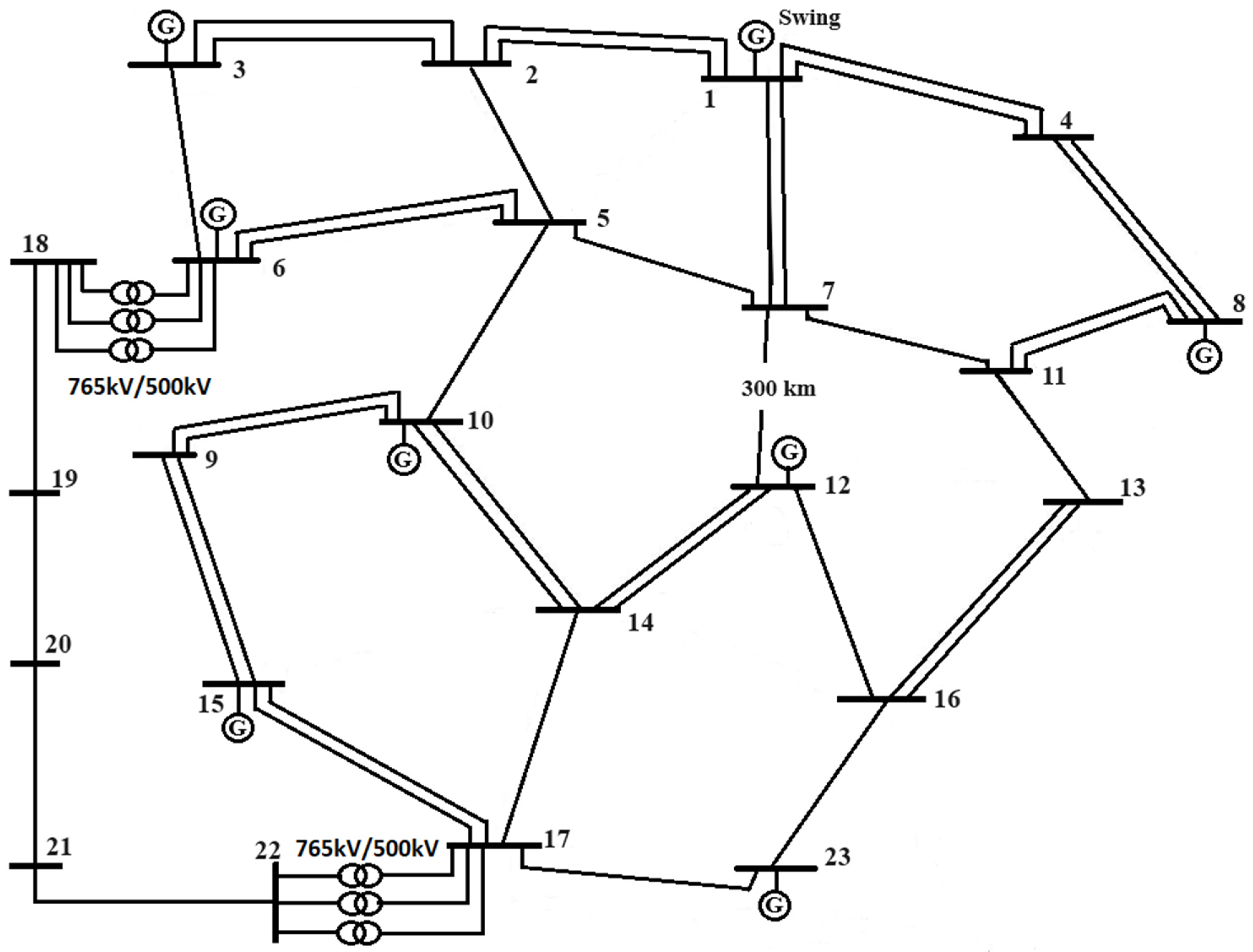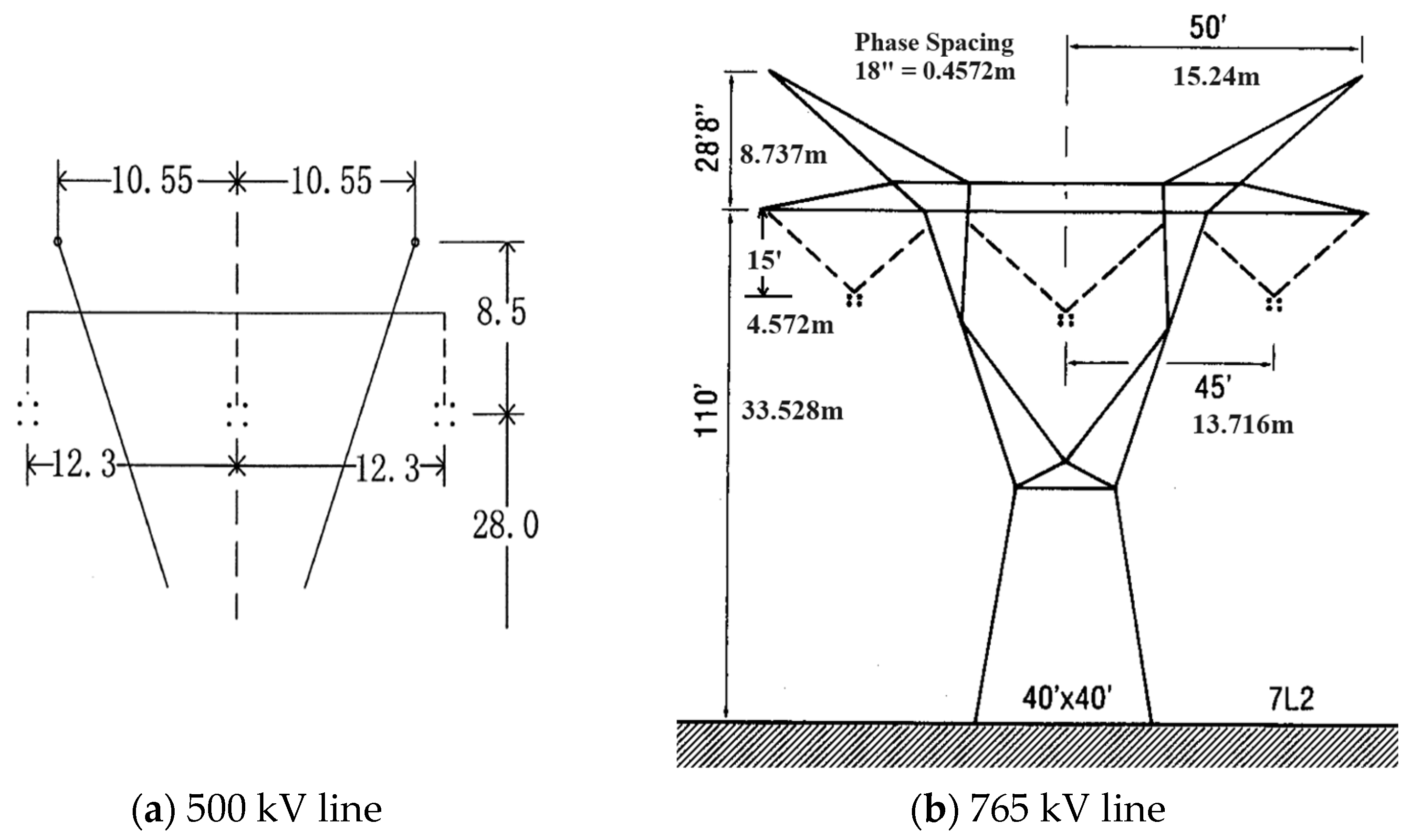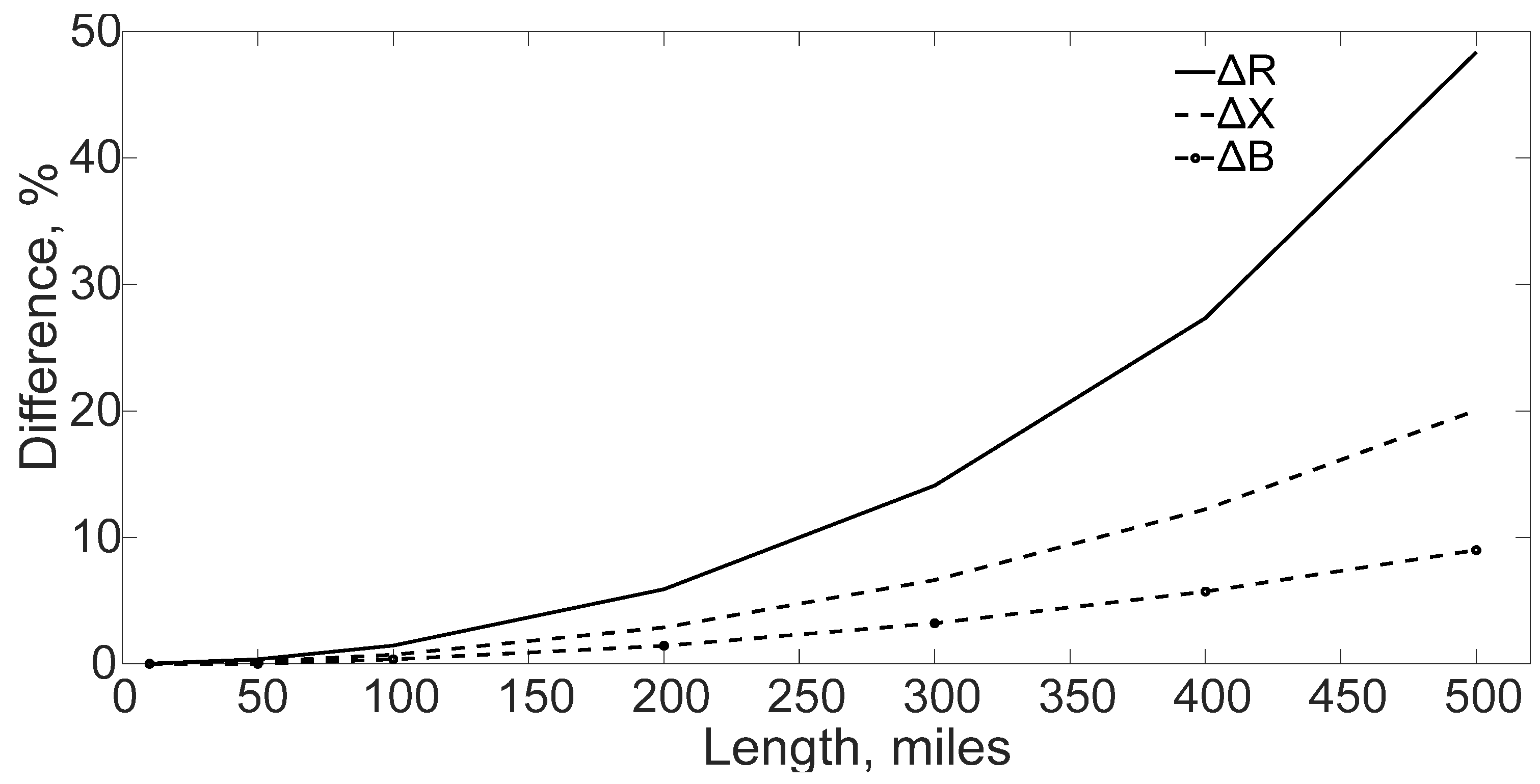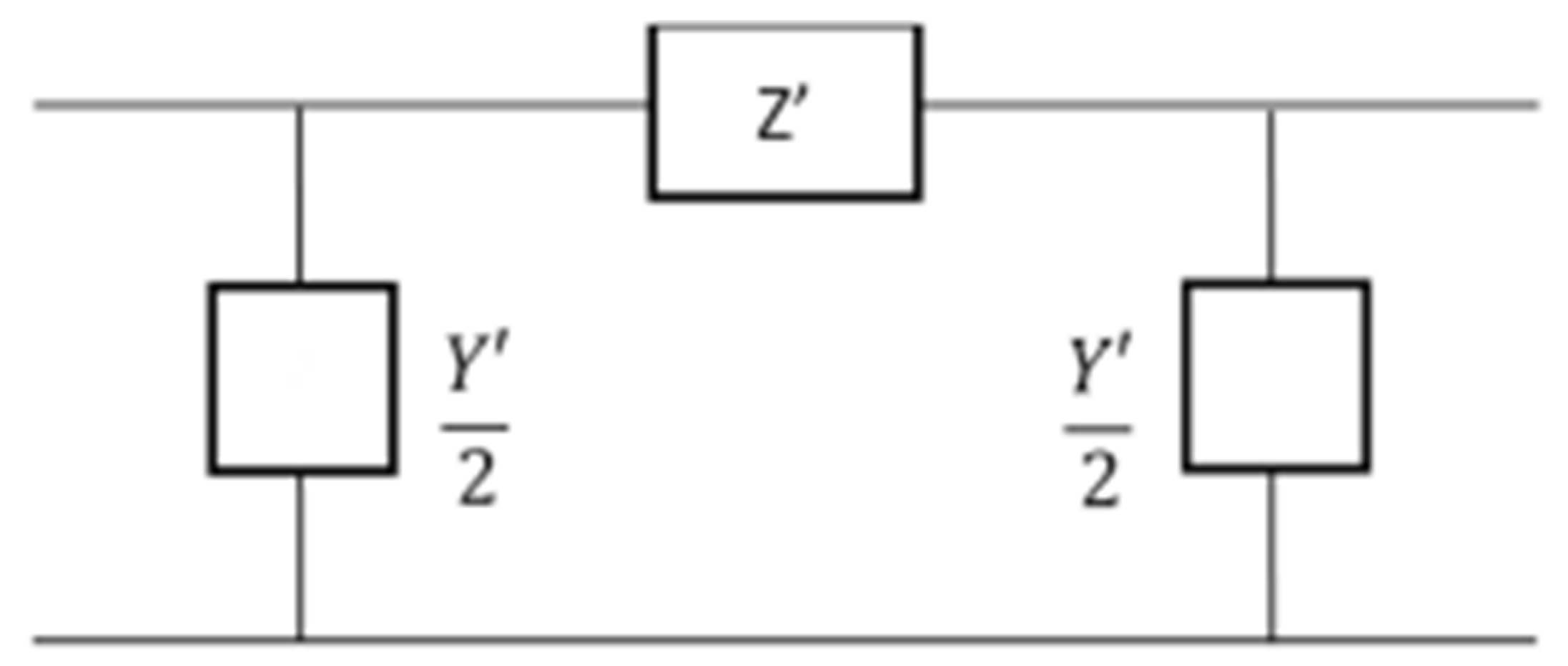An Extra-High Voltage Test System for Transmission Expansion Planning Studies Considering Single Contingency Conditions
Abstract
:1. Introduction
2. Overview of the Test System
2.1. Network Information
2.2. Transmission Line Configuration and Line Parameter
2.3. Transmisison Line Modeling
3. Problem Formulation for Load Flow Analysis
4. Load Flow Result and Analysis
4.1. Normal Operating Situation
4.2. Contingency Operation
5. Transmission Expansion Planning (TEP)
- Candidate I: Three-line connections to bus 17 from bus 24.
- Candidate II: Three-line connections to bus 23 from bus 24 and one additional line connection between bus 17 and bud 23
- Candidate III: Two-line connections to bus 17 and one-line connection to bus 23 from bus 24
- Candidate IV: One-line connections to bus 17 and two-line connections to bus 23 from bus 24.
- Candidate V: Two-line connection from bus 24 to bus 22 with an intermediate substation at the middle of the line.
5.1. Cost Analysis of TEP Candidates
- Higher Power Transfer Capacity: The 765 kV transmission lines allow for significantly higher power transfer capacity over long distances compared to 500 kV lines, which means a higher steady-state stability limit. This reduces the number of transmission lines required to connect remote wind farms, lowering the overall infrastructure costs.
- Reduced Power Losses: The 765 kV lines exhibit lower power losses compared to the 500 kV lines, leading to more efficient energy transmission. This results in long-term operational cost savings, especially for power plants located far from demand centers.
- Fewer Transmission Lines: Despite the higher upfront capital cost of 765 kV lines per circuit, it reduces the required number of transmission lines, which translates into fewer bays and transformers, further lowering the overall cost of grid expansion.
- Lower Lifetime Costs: Over 30 years, the savings from reduced power losses and infrastructure requirements make integrating via 765 kV lines the most cost-effective option, demonstrating the lowest total cost compared to integrating via 500 kV lines.
5.2. Detailed Load Flow Analysis of Optimal TEP Scenario
6. Conclusions
Author Contributions
Funding
Data Availability Statement
Conflicts of Interest
References
- International Energy Outlook–U.S. Energy Information Administration (EIA). Available online: https://www.eia.gov/outlooks/ieo/data.php (accessed on 16 July 2023).
- Larson, E.; Greig, C.; Jenkins, J.; Mayfield, E.; Pascale, A.; Zhang, C.; Drossman, J.; Williams, R.; Pacala, S.; Socolow, R.; et al. Net-Zero America: Potential Pathways, Infrastructure, and Impacts; interim report; Princeton University: Princeton, NJ, USA, 2020. [Google Scholar]
- Kissling, F.; Nefzger, P.; Nolasco, J.F.; Kaintzyk, U. Overhead Power Lines, Planning, Design, Construction; Springer: Berlin/Heidelberg, Germany, 2003; pp. 154–196. [Google Scholar]
- Glover, J.D.; Sarma, M.S.; Overbye, T.J. Power System Analysis and Design, 5th ed.; Cengage Learning: Stamford, CT, USA, 2012. [Google Scholar]
- Franck, C.M. HVDC circuit breakers: A review identifying future research needs. IEEE Trans. Power Del. 2011, 26, 998–1007. [Google Scholar] [CrossRef]
- Effah, F.B.; Watson, A.J.; Ji, C.; Amankwah, E.; Johnson, C.M.; Davidson, C.; Clare, J. Hybrid HVDC circuit breaker with self-powered gate drives. IET Power Electron. 2016, 9, 228–236. [Google Scholar] [CrossRef]
- Bucher, M.K.; Franck, C.M. Fault current interruption in multiterminal HVDC networks. IEEE Trans. Power Del. 2016, 31, 87–95. [Google Scholar] [CrossRef]
- Zhuo, Z.; Zhang, N.; Yang, J.; Kang, C.; Smith, C.; O’Malley, M.J.; Kroposki, B. Transmission expansion planning test system for AC/DC hybrid grid with high variable renewable energy penetration. IEEE Trans. Power Syst. 2020, 35, 2597–2608. [Google Scholar] [CrossRef]
- Dechamps, C.; Jamoulle, E. Interactive computer program for planning the expansion of meshed transmission networks. Int. J. Electr. Power Energy Syst. 1980, 2, 103–108. [Google Scholar] [CrossRef]
- Meneses, M.; Nascimento, E.; Macedo, L.H.; Romero, R. Transmission network expansion planning considering line switching. IEEE Access 2020, 8, 115148. [Google Scholar] [CrossRef]
- Rahmani, M. Study of New Mathematical Models for Transmission Expansion Planning Problem. Ph.D. Thesis, Ilha Solteira UNESP, São Paulo, Brazil, 2013. [Google Scholar]
- Romero, R.; Monticelli, A.; Garcia, A.; Haffner, S. Test systems and mathematical models for transmission network expansion planning. IEE Proc. Gener. Transm. Distrib. 2002, 149, 27. [Google Scholar] [CrossRef]
- Sierra, J.E.; Giraldo, E.A.; Lopez-Lezama, J.M. Weighting transmission loading relief nodal indexes for the optimal allocation of distributed generation in power systems. Contemp. Eng. Sci. 2018, 11, 2601–2611. [Google Scholar] [CrossRef]
- Xu, Q.; Hobbs, B.F. Value of model enhancements: Quantifying the benefit of improved transmission planning models. IET Gener. Transm. Distrib. 2019, 13, 2836–2845. [Google Scholar] [CrossRef]
- Haffner, S.; Monticelli, A.; Garcia, A.; Mantovani, J.; Romero, R. Branch and bound algorithm for transmission system expansion planning using a transportation model. IEE Proc. Gener. Transm. Distrib. 2000, 147, 149. [Google Scholar] [CrossRef]
- Mutlu, S.; Şenyiğit, E. Literature review of transmission expansion planning problem test systems: Detailed analysis of IEEE-24. Electr. Power Syst. Res. 2021, 201, 107543. [Google Scholar] [CrossRef]
- Pena, I.; Martinez-Anido, C.B.; Hodge, B.-M. An extended IEEE 118-bus test system with high renewable penetration. IEEE Trans. Power Syst. 2018, 33, 281–289. [Google Scholar] [CrossRef]
- Power Systems Test Cases Archive. Available online: https://labs.ece.uw.edu/pstca/ (accessed on 16 August 2024).
- Birchfield, A.B.; Xu, T.; Gegner, K.M.; Shetye, K.S.; Overbye, T.J. Grid Structural Characteristics as Validation Criteria for Synthetic Networks. IEEE Trans. Power Sys. 2017, 32, 3258–3265. [Google Scholar] [CrossRef]
- Birchfield, A.B.; Xu, T.; Gegner, K.M.; Shetye, K.S.; Overbye, T.J. Statistical Considerations in the Creation of Realistic Synthetic Power Grids for Geomagnetic Disturbance Studies. IEEE Trans. Power Syst. 2017, 32, 1502–1510. [Google Scholar] [CrossRef]
- Birchfield, A.B.; Xu, T.; Gegner, K.M.; Shetye, K.S.; Overbye, T.J. Application of Large-Scale Synthetic Power System Models for Energy Economic Studies. In Proceedings of the 2017 50th Hawaii International Conference on System Sciences (HICSS), Koloa, HI, USA, 4–7 January 2017. [Google Scholar]
- Birchfield, A.B.; Xu, T.; Gegner, K.M.; Shetye, K.S.; Overbye, T.J. Building synthetic power transmission networks of many voltage levels, spanning multiple areas. In Proceedings of the 2018 51st Hawaii International Conference on System Sciences (HICSS), Koloa, HI, USA, 3–6 January 2018. [Google Scholar]
- Birchfield, A.B.; Xu, T.; Overbye, T.J. Power Flow Convergence and Reactive Power Planning in the Creation of Large Synthetic Grids. IEEE Trans. Power Syst. 2018, 33, 6667–6674. [Google Scholar] [CrossRef]
- Aguado, J.A.; Racero, A.J.S.; De La Torre, S. Optimal operation of electric railways with renewable energy and electric storage systems. IEEE Trans. Smart Grid 2018, 9, 993–1001. [Google Scholar] [CrossRef]
- Ahmadi, M.; Jafari Kaleybar, H.; Brenna, M.; Castelli-Dezza, F.; Carmeli, M.S. Integration of Distributed Energy Resources and EV Fast-Charging Infrastructure in High-Speed Railway Systems. Electronics 2021, 10, 2555. [Google Scholar] [CrossRef]
- Brenna, M.; Foiadelli, F.; Kaleybar, H.J. The Evolution of Railway Power Supply Systems Toward Smart Microgrids: The concept of the energy hub and integration of distributed energy resources. IEEE Electrif. Mag. 2020, 8, 12–23. [Google Scholar] [CrossRef]
- Dhamala, B.; Ghassemi, M. A Test System Meeting Requirements under Normal and Contingency Conditions at Multiple Loadings for Transmission Expansion Planning. In Proceedings of the IEEE Dallas Circuits and Systems Conference (DCAS), Dallas, TX, USA, 19–21 April 2024. [Google Scholar]
- Dhamala, B.; Ghassemi, M. A High Voltage Test System Meeting Requirements Under Normal and All Single Contingencies Conditions of Peak, Dominant, and Light Loadings for Transmission Expansion Planning Studies. In Proceedings of the 2024 IEEE Texas Power and Energy Conference (TPEC), College Station, TX, USA, 12–13 February 2024. [Google Scholar]
- Dhamala, B.; Ghassemi, M. A Test System for Transmission Expansion Planning Studies. Electronics 2024, 13, 664. [Google Scholar] [CrossRef]
- Dhamala, B.; Ghassemi, M. Smart Transmission Expansion Planning Based on the System Requirements: A Comparative Study with Unconventional Lines. Energies 2024, 17, 1912. [Google Scholar] [CrossRef]
- Dhamala, B.; Ghassemi, M. Comparative Study of Transmission Expansion Planning with Conventional and Unconventional High Surge Impedance Loading (HSIL) Lines. In Proceedings of the IEEE PES General Meeting, Seattle, WA, USA, 21–25 July 2024. [Google Scholar]
- Wei-Gang, H. Study on conductor configuration of 500 kV Chang-Fang compact line. IEEE Trans. Power Deliv. 2003, 18, 1002–1008. [Google Scholar] [CrossRef]
- Ellert, F.J.; Miske, S.A.; Truax, C.J. EPRI Transmission Line Reference Book: 345 kV and Above, 2nd ed.; Electric Power Research Institute: Washington, DC, USA, 1982; pp. 11–62. [Google Scholar]
- Reactive Power Capability and Interconnection Requirements for PV and Wind Plants. Sandia National Laboratories. Available online: http://www.esig.energy/wiki-main-page/reactive-power-capability-and-interconnection-requirements-for-pv-and-wind-plants/#cite_note-1 (accessed on 4 August 2024).
- Transmission Cost Estimation Guide for MTEP23. Midcontinent Independent System Operator (MISO). May 2024. Available online: https://cdn.misoenergy.org/MISO%20Transmission%20Cost%20Estimation%20Guide%20for%20MTEP24337433.pdf (accessed on 4 August 2024).
- Madigan, G.; Lee, C.; Dixit, A.; Zhong, X.; Saha, T.; Ashworth, P. Comparing High Voltage Overhead and Underground Transmission Infrastructure: Cost and Economic Aspects. September 2023. Available online: https://s37430.pcdn.co/ciet/wp-content/uploads/sites/16/2023/11/04_Cost_Economics_Aspects.pdf (accessed on 4 August 2024).
- Teegala, S.K.; Singal, S.K. Economic Analysis of Power Transmission Lines using Interval Mathematics. J. Electr. Eng. Technol. 2015, 10, 1471–1479. [Google Scholar] [CrossRef]
- CPV Three Rivers Energy Center, Illinois, US. Power Technology. Available online: https://www.power-technology.com/projects/cpv-three-rivers-energy-center-illinois-us/ (accessed on 4 August 2024).
- Technologies | Electricity | 2023 | ATB | NREL. Available online: https://atb.nrel.gov/electricity/2023/technologies (accessed on 4 August 2024).
- Natural Gas Futures Contract 1 (Dollars per Million Btu). Available online: https://www.eia.gov/dnav/ng/hist/rngc1M.htm (accessed on 4 August 2024).







| Bus | Bus Type | (p.u.) | Base kV | Pg (MW) | (Mvar) | (Mvar) | PL (MW) | QL (MW) | Shunt Compensation |
|---|---|---|---|---|---|---|---|---|---|
| 1 | Slack | 1.00 | 500 | ||||||
| 2 | PQ | - | 500 | - | - | - | 1700.00 | 823.34 | 300 Mvar (Capacitor) |
| 3 | PV | 1.00 | 500 | 3600 | −1080 | 2160 | 1700.00 | 823.34 | - |
| 4 | PQ | - | 500 | - | - | - | 1600.00 | 774.91 | 150 Mvar (Capacitor) |
| 5 | PQ | - | 500 | - | - | - | 1700.00 | 823.34 | 250 Mvar (Capacitor) |
| 6 | PV | 1.00 | 500 | 3600 | −1080 | 2160 | 1700.00 | 823.34 | - |
| 7 | PQ | - | 500 | - | - | - | 1900.00 | 920.21 | 350 Mvar (Capacitor) |
| 8 | PV | 1.00 | 500 | 3600 | −1080 | 2160 | 1600.00 | 774.92 | - |
| 9 | PQ | - | 500 | - | - | - | 1700.00 | 823.34 | 200 Mvar (Capacitor) |
| 10 | PV | 1.00 | 500 | 3500 | −1080 | 2160 | 1800.00 | 871.78 | - |
| 11 | PQ | - | 500 | - | - | - | 1700.00 | 823.34 | 350 Mvar (Capacitor) |
| 12 | PV | 1.00 | 500 | 3300 | −1080 | 2160 | 1600.00 | 774.92 | - |
| 13 | PV | 1.00 | 500 | 3500 | −1080 | 2160 | 1800.00 | 871.77 | - |
| 14 | PQ | - | 500 | - | - | - | 2100.00 | 1017.00 | 300 Mvar (Capacitor) |
| 15 | PV | 1.00 | 500 | 3000 | −1050 | 2100 | 1700.00 | 823.34 | - |
| 16 | PQ | - | 500 | - | - | - | 1800.00 | 871.77 | 400 Mvar (Capacitor) |
| 17 | PQ | - | 500 | - | - | - | 2000.00 | 968.64 | - |
| 18 | PQ | - | 765 | - | - | - | - | - | - |
| 19 | PQ | - | 765 | - | - | - | - | - | 600 Mvar (Reactor) |
| 20 | PQ | - | 765 | - | - | - | - | - | 600 Mvar (Reactor) |
| 21 | PQ | - | 765 | - | - | - | - | - | 550 Mvar (reactor) |
| 22 | PQ | - | 765 | - | - | - | - | - | - |
| 23 | PV | - | 500 | 2200 | - | - | 1600.00 | 774.91 | - |
| From | To | No. Circuit | Line Length (km) | From | To | No. Circuit | Line Length (km) | |
| 1 | 2 | 2 | 410.33 | 1 | 4 | 2 | 426.78 | |
| 1 | 7 | 1 | 370.92 | 2 | 3 | 2 | 436.70 | |
| 2 | 5 | 2 | 294.56 | 3 | 6 | 2 | 349.56 | |
| 4 | 8 | 2 | 416.14 | 5 | 7 | 1 | 435.50 | |
| 5 | 10 | 1 | 376.35 | 7 | 12 | 2 | 300.05 | |
| 8 | 11 | 2 | 349.10 | 9 | 10 | 2 | 447.28 | |
| 9 | 15 | 2 | 398.20 | 10 | 14 | 2 | 392.74 | |
| 11 | 13 | 1 | 261.30 | 12 | 16 | 1 | 406.46 | |
| 13 | 16 | 2 | 417.27 | 14 | 15 | 1 | 458.18 | |
| 14 | 17 | 1 | 403.64 | 15 | 17 | 2 | 402.16 | |
| 16 | 23 | 1 | 324.54 | 17 | 23 | 1 | 341.84 | |
| 5 | 18 | 3 | Transformer | 22 | 17 | 3 | Transformer | |
| 18 | 29 | 1 | 230 | 19 | 20 | 1 | 230 | |
| 20 | 21 | 1 | 230 | 21 | 22 | 1 | 230 |
| Voltage Level | Conductor Type | Stranding | Diameter (cm) | Sub-Conductor Spacing (m) | Res. At 75 Deg (Ohm/km) | Ampacity of Single con. (A) |
|---|---|---|---|---|---|---|
| 500 kV | 4 × Macaw | 42/7 | 2.6797 | 0.4572*0.4572 | 0.09744 | 870 |
| 765 kV | 4 × Dipper | 45/7 | 3.5180 | 0.4572*0.4572 | 0.05446 | 1210 |
| Line Constraints | Capacity | |||
|---|---|---|---|---|
| r (p.u./km) | x (p.u./km) | y (p.u./km) | ||
| 500 kV line | 9.1600 × 10−6 | 1.3240 × 10−4 | 0.01223 | SIL = 960 MW |
| 765 kV line | 2.32645 × 10−6 | 5.6975 × 10−5 | 0.02863 | SIL = 2230 MW |
| Transformer | 0.001290 p.u. | 0.025740 p.u. | - | 500 MVA |
| Line Outage | Lowest Voltage | The Highest Line Loading | ||
|---|---|---|---|---|
| p.u. | Bus# | %Loading | Line | |
| 1–2 (1 line) | 0.987 | 2 | 44.12% | 1–7 |
| 1–4 (1 line) | 0.931 | 4 | 43.70% | 1–7 |
| 1–7 (1 line) | 0.921 | 7 | 57.39% | 1–7 |
| 2–3 (1 line) | 0.968 | 2 | 44.50% | 2–3 |
| 2–5 | 0.968 | 7 | 46.41% | 1–7 |
| 3–6 | 0.983 | 2 | 43.84% | 1–7 |
| 4–8 (1 line) | 0.947 | 4 | 39.46% | 1–7 |
| 5–6 | 0.966 | 5 | 42.73% | 5–6 |
| 5–7 | 0.949 | 7 | 40.22% | 1–7 |
| 5–10 | 0.974 | 20 | 41.42% | 1–7 |
| 7–11 | 0.947 | 11 | 40.51% | 1–7 |
| 7–12 | 0.972 | 7 | 39.94% | 1–7 |
| 8–11 (1 line) | 0.908 | 11 | 46.61% | 8–11 |
| 9–10 | 0.918 | 9 | 40.95% | 1–7 |
| 9–15 | 0.933 | 9 | 40.72% | 1–7 |
| 10–14 (1 line) | 0.985 | 20 | 41.11% | 1–7 |
| 11–13 | 0.949 | 11 | 39.83% | 1–7 |
| 12–14 (1 line) | 0.977 | 20 | 44.19% | 12–14 |
| 12–16 (1 line) | 0.944 | 16 | 39.80% | 1–7 |
| 13–16 (1 line) | 0.900 | 16 | 47.72% | 13–16 |
| 14–17 | 0.924 | 17 | 40.70% | 1–7 |
| 15–17 (1 line) | 0.933 | 17 | 40.80% | 1–7 |
| 16–23 | 0.958 | 23 | 40.76% | 1–7 |
| 17–23 | 0.915 | 17 | 40.72% | 1–7 |
| 18–22 | 0.917 | 5 | 46.40% | 1–7 |
| TEP Candidate | No. of Lines from 24 to 17 or 22 | No. of Lines from 24 to 23 | No. of Lines from 17 to 23 | Power Loss | No. of Additional Bays | No. of Additional Transformer | Required Total Shunt Compensations | ||
|---|---|---|---|---|---|---|---|---|---|
| 500 kV | 765 kV | 500 kV | 765 kV | ||||||
| I | 3 | - | - | 396.85 MW | 7 | 1 | - | 2300 Mvar Cap. 550 Mvar Ind. | 2300 Mvar Ind. |
| II | - | 3 | 1 | 432.68 MW | 9 | - | - | 2300 Mvar Cap. 550 Mvar Ind. | 1900 Mvar Ind. |
| III | 2 | 1 | - | 417.66 MW | 7 | 1 | - | 2300 Mvar Cap. 450 Mvar Ind. | 2150 Mvar Ind. |
| IV | 1 | 2 | - | 417.26 MW | 7 | - | - | 2300 Mvar Cap. 2200 Mvar Ind. | 1800 Mvar Ind. |
| V | 2(765 kV) | - | - | 381.32 MW | 2 | 13 | 2 (500 MVA, 500/765 kV) | 2300 Mvar Cap. 800 Mvar Ind. | 3350 Mvar Ind. |
| Voltage Level | Average Cost of Line in the U.S. | Shunt Reactor | Shunt Capacitor | Cost of Bay (Breaker and Half) | Cost of 500/765 kV Power Transformer |
|---|---|---|---|---|---|
| 500 kV | USD 2.8003 Million/km | USD 24,806/Mvar | USD 11,873/Mvar | USD 7.3 Million | USD 12,510/MVA |
| 765 kV | USD 3.5211 Million/km | USD 35,831/Mvar | USD 11,873/Mvar | USD 21.9 Million |
| TEP Candidate | Cost of Line, Bay/Substation, and Shunt Compensation | Maintenance Cost | Operation Cost: Cost of Power Loss | Total Cost of TEP USD (Million) | |||||
|---|---|---|---|---|---|---|---|---|---|
| Line Cost USD (Million) | Bay/Subst-Ation Cost USD (Million) | Additional Reactor Cost USD (Million) | 500/765 kV Transformer USD (Million) | Capital Investment USD (Million) | Fuel Cost USD (Million) | O&M cost USD (Million) | |||
| I | 5040.54 | 73.0 | 40.51655 | - | 625.4826 | 1.508 | 2.036627 | 6.397806 | 5789.4816 |
| II | 6417.8396 | 65.7 | 26.18415 | - | 796.3923 | 38.7712 | 52.36237 | 164.4898 | 7561.7394 |
| III | 5180.555 | 73 | 32.6613 | - | 642.8572 | 23.1504 | 31.26573 | 98.217353 | 6081.7069 |
| IV | 5320.57 | 51.1 | 18.88015 | - | 660.2317 | 22.7344 | 30.7039 | 96.452441 | 6200.6726 |
| V | 4225.32 | 299.3 | 91.5068 | 12.51 | 786.4825 | - | −19.7763 (Saving) | −62.1249 (Saving) | 5333.2180 |
Disclaimer/Publisher’s Note: The statements, opinions and data contained in all publications are solely those of the individual author(s) and contributor(s) and not of MDPI and/or the editor(s). MDPI and/or the editor(s) disclaim responsibility for any injury to people or property resulting from any ideas, methods, instructions or products referred to in the content. |
© 2024 by the authors. Licensee MDPI, Basel, Switzerland. This article is an open access article distributed under the terms and conditions of the Creative Commons Attribution (CC BY) license (https://creativecommons.org/licenses/by/4.0/).
Share and Cite
Dhamala, B.; Ghassemi, M. An Extra-High Voltage Test System for Transmission Expansion Planning Studies Considering Single Contingency Conditions. Electronics 2024, 13, 3937. https://doi.org/10.3390/electronics13193937
Dhamala B, Ghassemi M. An Extra-High Voltage Test System for Transmission Expansion Planning Studies Considering Single Contingency Conditions. Electronics. 2024; 13(19):3937. https://doi.org/10.3390/electronics13193937
Chicago/Turabian StyleDhamala, Bhuban, and Mona Ghassemi. 2024. "An Extra-High Voltage Test System for Transmission Expansion Planning Studies Considering Single Contingency Conditions" Electronics 13, no. 19: 3937. https://doi.org/10.3390/electronics13193937








